Do you want to try the best foods Germany has to offer on your trip? You will want to check out this German food guide for tips on what to eat in Germany. From breakfast to dessert, all year long, we’ve got you covered.
Isn’t it amazing that even after living someplace for many years, you fall into a pattern of the types of food you like to eat? Jim and I lived in Germany for a total of about 15 years, lately in the Vilseck area, and in that time we lived in three different states giving us a pretty good look into the local specialties and an eye for really good and authentic food experiences.
It’s taken us a while to put together, but it’s one another one more world food guide to help you discover the best and most authentic and traditional foods in each country. This way, you can quickly and easily decide what to eat in Germany when you visit, which for foodies like us, we think is vital to having a great trip.
In this article, you’ll learn what to eat in Germany:
- German Sausage
- German Grocery Stores and Markets
- German Restaurant Etiquette
- What to Eat in Germany
- Breakfast
- Main Dishes
- Desserts
- Cheap Eats
- Kids Food
- Seasonal Dishes
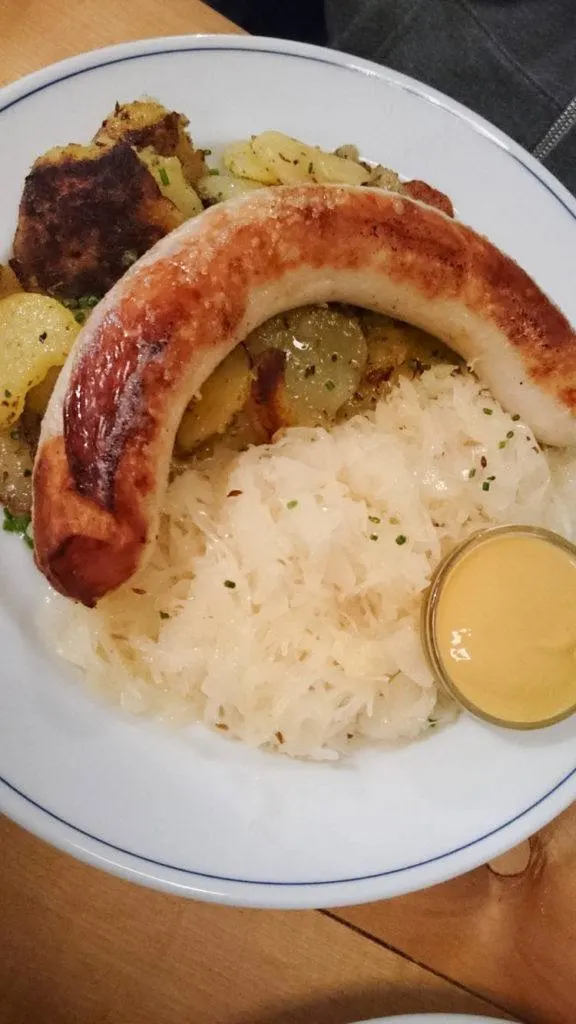
Myth Busting! Germans Eat Sausage, More Sausage, and Even More Sausage.
While it’s true that you can find the most amazing sausages in Germany, there is much more to German cuisine. When I first moved to the country at age 22, I was not a fan of any sausage, and to be honest, it’s still far from my favorite thing to eat. Although I do have a few that I love, like the traditional bratwurst or the Thuringer wurst.
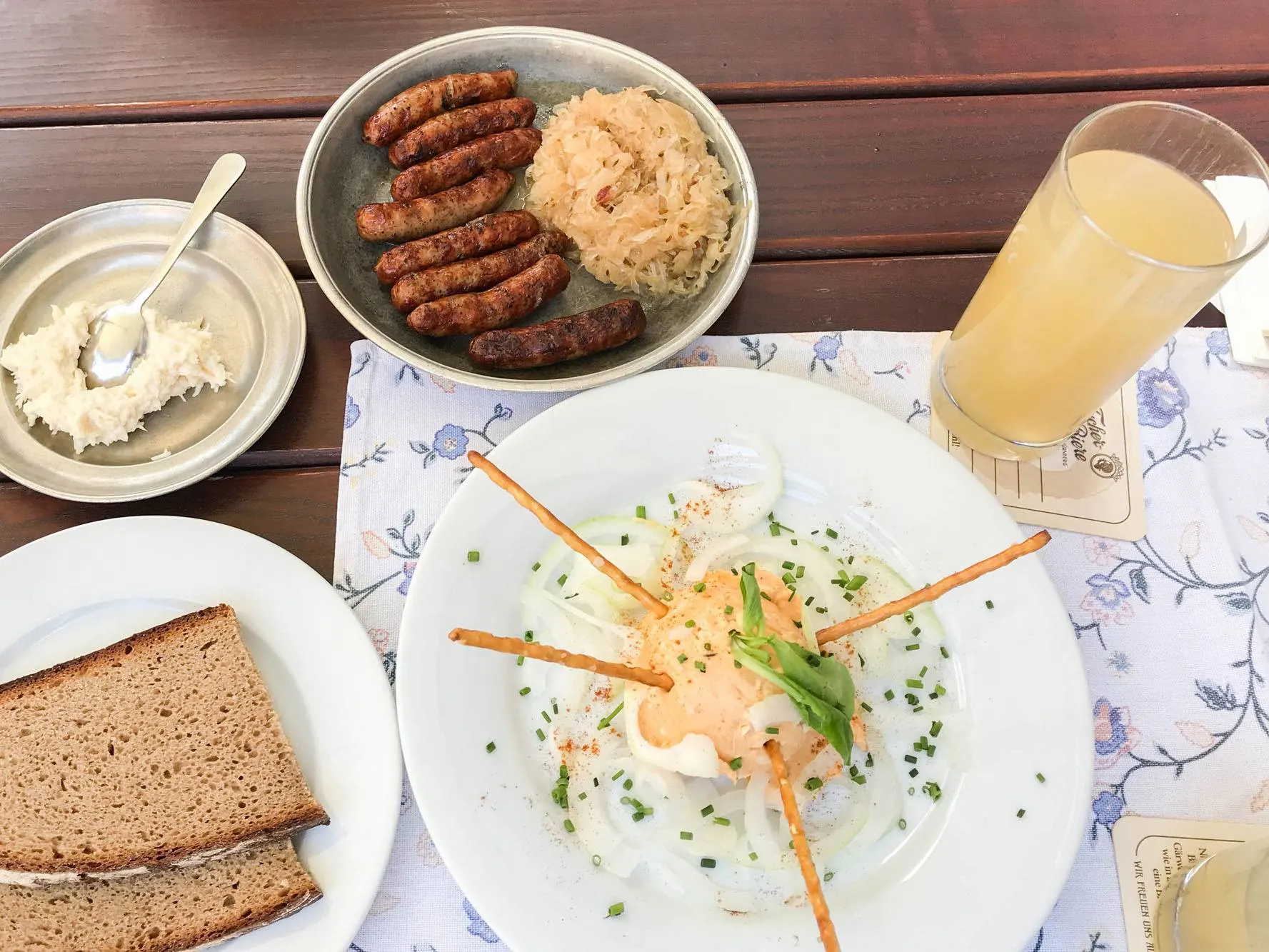
Our Traditional German Food Guide – What to Eat in Germany
From breakfast to dinner, you will be able to look at a menu and figure out what you want as you discover some of the unusual things to do in Germany. German food is both hearty and healthy, and there are plenty of vegetarian, vegan, and ethnic foods to try as well. You won’t go hungry on your trip if you use this fantastic guide to help you figure out what to eat in Germany.
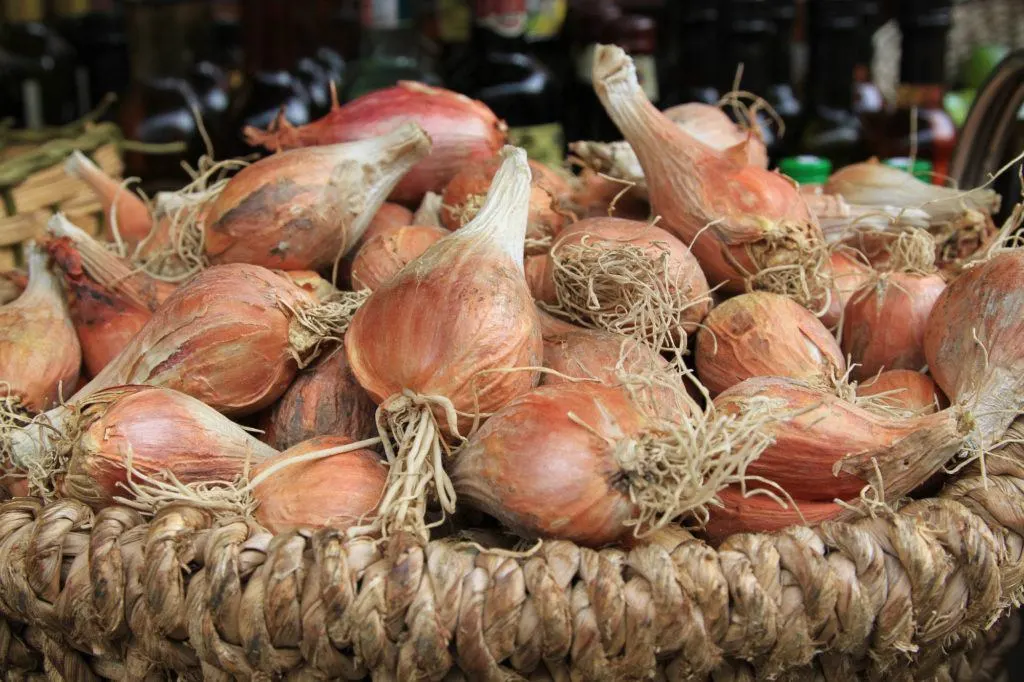
What to Eat in Germany – Grocery Stores and Markets
There’s nothing better than cooking your own meals when you get a chance. If you do, make sure to find out when the local market comes to town, smaller towns might have only one per week, but most cities will have at least two. A typical market will have more than just produce.
Weekly Markets
In our little town, we had a variety of stalls, to include: eggs, poultry, fresh pasta and sauces, a few butchers, fishmongers, cheese, spices and herbs, olives and marinated goods, and so much more.
We used to make sure we had our list ready each Saturday when our market was in town. We always stopped at the egg lady, who gave us an extra egg every time, as well as the local farmers who didn’t come every week. They would have whatever they’d harvested or made that week and even though it might not have been on our list, we’d get it because it was so fresh and tasty.
Check with your hotelier to find out what days the market comes to where you are staying. Even if you aren’t going to cook, you can find some great fruits and sandwich makings for a fantastic picnic lunch.
Grocery Stores
Most grocery stores have a bakery that has a stall in the front or their own further in the back, as well as their butcher, cheese, and marinated goods counters so it’s easy to find some fresher foods there as well.
The grocery stores are also where you would find your dairy products, packaged and frozen goods. When we wanted a dessert, getting a frozen apfelstrudel and a can of whipped cream always did the job. So even if you don’t have a kitchen where you are staying, check out the stores.
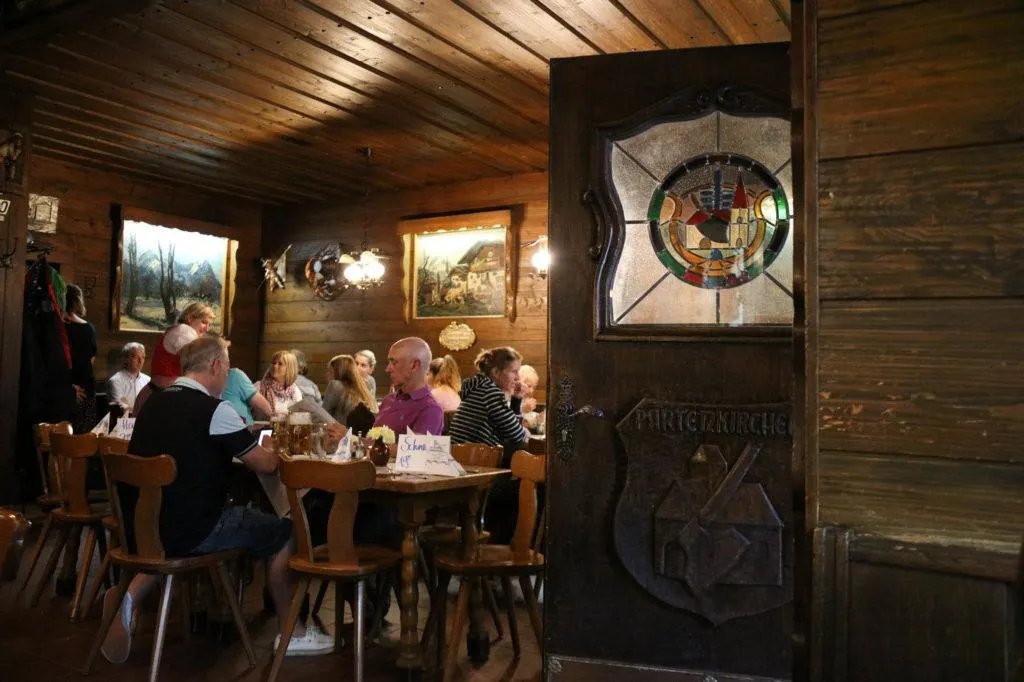
Like podcasts? Listen to this one on German foods!
Etiquette in German restaurants
It goes without saying that if you are visiting Germany, you will probably eat the majority of your meals in German restaurants, so we wanted to give you a few tips on what to expect.
Reservations
Gone are the days of walking into a German restaurant and easily finding a seat. If you are doing your research on great places to eat, go the extra step and make a reservation. Most restaurants will understand your English, but if you get intimidated have your hotel staff call for you.
Whether you’ve made a reservation or not, look for the little signs on the table (see the photo above) before seating yourself. Sometimes, if you are eating early, say 5:30, you’ll have time to finish before the people who reserved the table will get there, but the manager still might not let you sit there, so be patient.
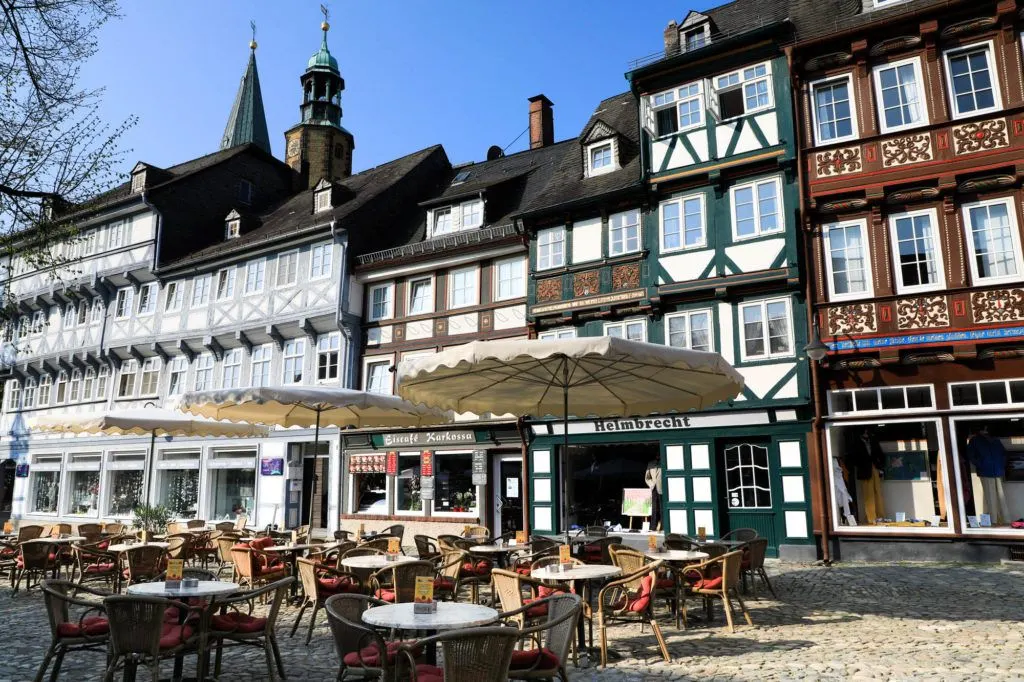
Seating
Upon entering most German restaurants, there usually will not be anyone to seat you. Just go in and find a table on your own. In many beer halls and larger restaurants, the tables might have more seats than people sitting, and you can share.
Sharing a table might be a little disconcerting at first, but it’s really a good idea for a couple of reasons. First, you get to eat at the restaurant you were hoping to eat at, and second many times you might make some new friends. This has happened to us on many occasions.
If your table mates aren’t that friendly, or just want to have an intimate dinner, they will leave you completely alone, so that’s okay, too.
The Menu
The waiter will usually bring your menu and ask right away if you want a drink. You can’t go wrong ordering a “bier vom fass” (beer on tap) or a glass of sweet (suss) or dry (trocknen) weisswein (white wine). You can find rosé or red as well, but Germans are best at white wines.
For kids or for non-alcohol drinks, you should try their juices. For years I only drank apple juice at every meal, because it’s more like a cider. The grape juice is amazing too. Of course, you can order a soda or a variety of other drinks as well. If you don’t like the straight juice, they mix it with sparkling water as well. It’s called a “schorle” so for sparkling apple juice order an “apfelschorle.” Yum!
Water, however, is not usually commonly brought to your table. If you ask for water, you need to specify “leistungswater” for a glass of free tap water. All other water will be sold to you, fresh or sparkling.
When the drinks are brought, the waitress will ask you to order. Many menus have a few translations and English is usually one of them, but don’t be afraid to ask if it doesn’t. Someone in the restaurant will speak English.
The Bill and Tipping
To ask for the bill, you call the waiter and ask for “rechnung, bitte,” and he will go and get it then stand right there and wait for you to pay. If you pay in cash, he will give you the change right away. Many, but definitely not all, German restaurants take credit cards now, and that makes it pretty easy.
Tipping is casual, and it’s a good idea to round up to the next Euro and then kick in a couple more. It’s nothing to stress about, which I personally love. A normal tip is up to and around 5 Euros for a couple.
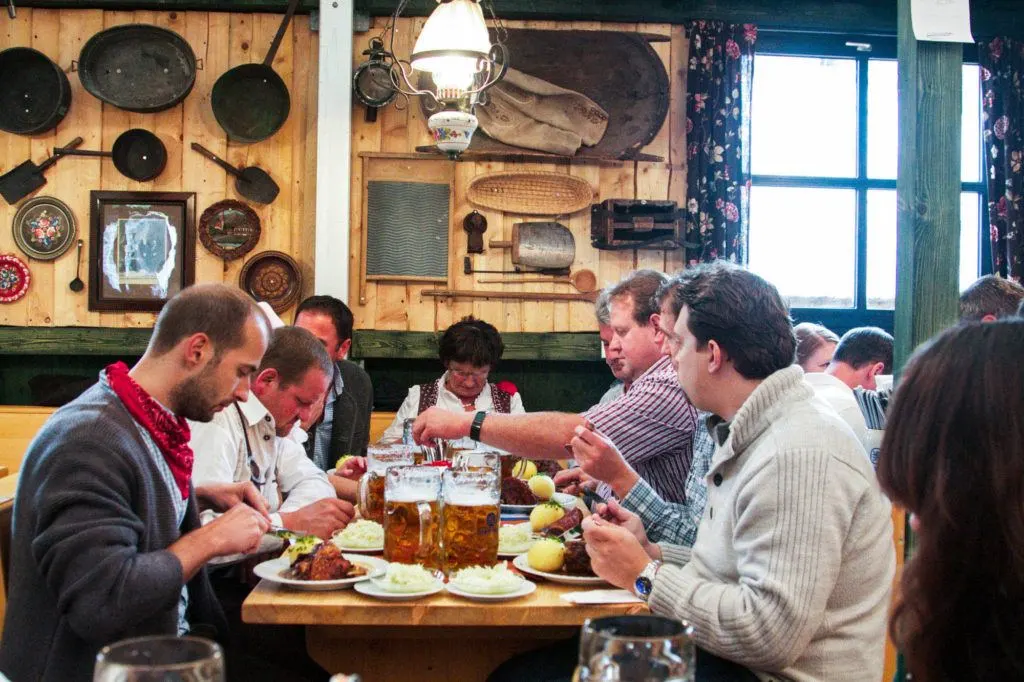
What To Eat In Germany and German Restaurants
Eating out in Germany used to be much harder, because German restaurants would never serve breakfast. They would be open from 11:30 – 3:00 for lunch, then open back up about 5:30 with the restaurant packed by 7:30. It was good for the workers, but it made it a little difficult on the tourists.
Traveling around, you always had to worry about the time. Today, many German restaurants still operate under the same schedule. However, many more are open all day long, called “durchgehend” (throughout). So their hours will be something like 11:30 – 11:30.
It’s also more common to find places that offer breakfast, and even a great brunch on the weekend. These are most often found in bakeries or cafés, as opposed to dinner restaurants.
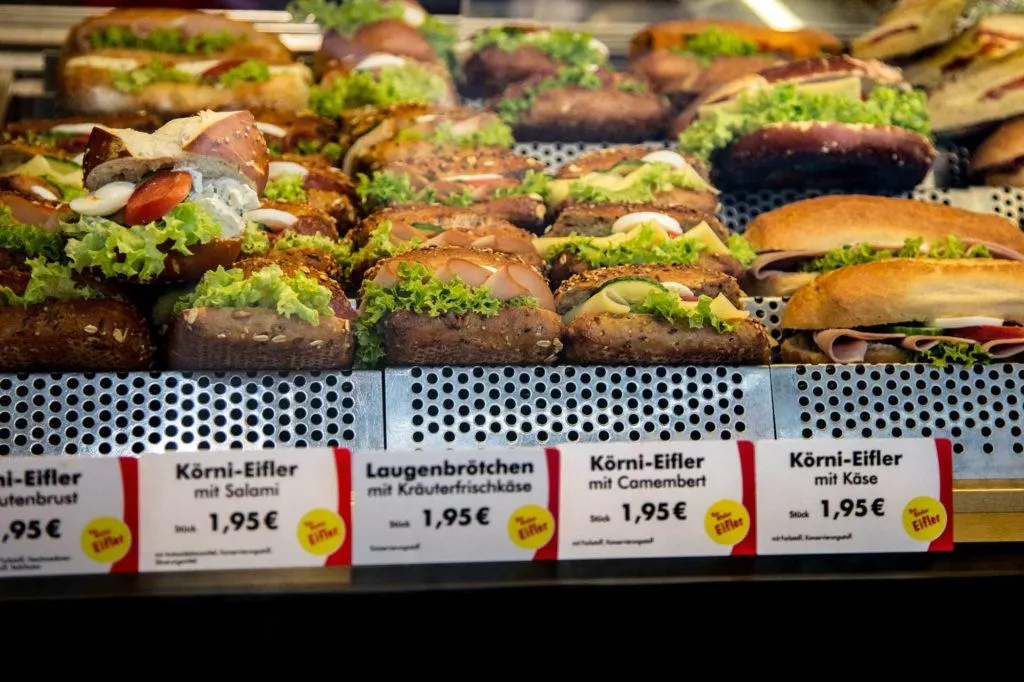
Breakfast or Frühstück
Other than brunch, breakfast is not a meal that many people eat out. Most have a small muesli or brotchen (roll) breakfast at home, or stop at either a baker, butcher, or grocery store on the way to work to grab a sandwich.
This takes a bit of getting used to if you live here, but luckily while traveling hotels offer a great breakfast.
A German hotel breakfast usually consists of:
- Brotchen and other rolls and bread, often with lots of grains and seeds.
- Cold cuts, which almost always at minimum are ham and salami.
- Muesli and another cereal
- Yogurt
- Some cheeses (again usually sliced for a sandwich)
- Fresh or canned fruit
- Eggs (hardboiled, scrambled, or sometimes to order)
You are not going to go hungry, but the ways hotels are booking it might cost you anywhere from 5 – 16 Euro for this. If you can load up and eat a lot, it’s a good deal. Otherwise, take a lesson from the locals and get your sandwich elsewhere, like a gas station, butcher shop, or a bakery.
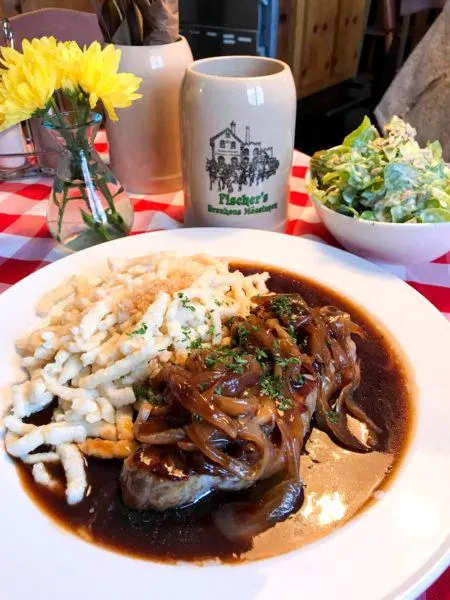
Traditional German Food Guide – Main Dishes or Hauptgerichte
If you are looking for traditional German food, there are plenty of options. From hotel restaurants to brew pubs, you will have no trouble finding authentic dishes. Most meals come with a meat, side salad, and either potatoes or dumplings.
Cost for this one course meal at a normal walk-in restaurant is about 18-22 Euros for dinner, and it will keep you full for some time. Most restaurants will offer a limited lunch menu, which is small portions, but it’s a good deal that will cost about 12-18 Euros.
Many Germans love a good bowl of soup or salad before their meal, and there are many soups to choose from. Adding soup will only add about 5 or 6 Euros to your bill, and is a good choice for kids or for a lighter meal.
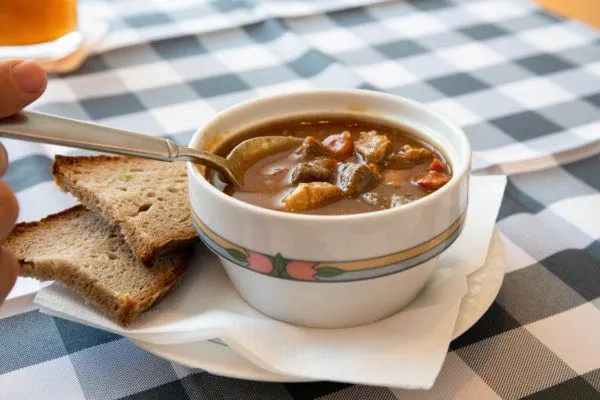
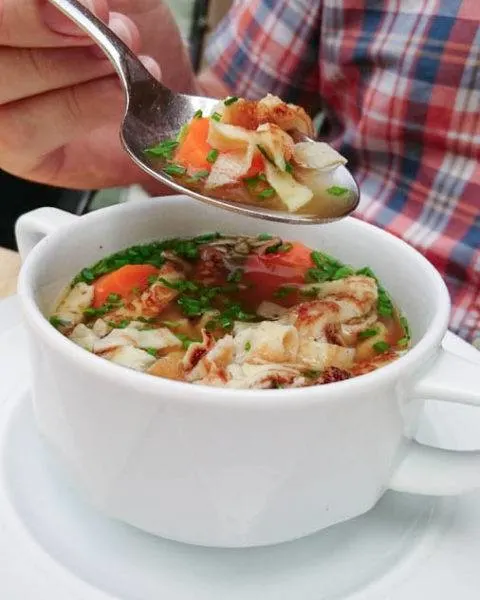
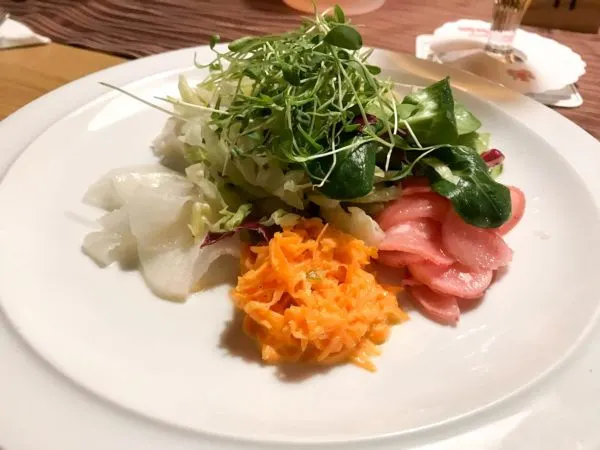
Every menu will offer you main courses that include a variety of steaks, pork dishes, some chicken dishes, fish choices, and maybe even a vegetarian option or two. The latter is becoming much more popular, and of course there are full restaurants where it’s only vegan or vegetarian.
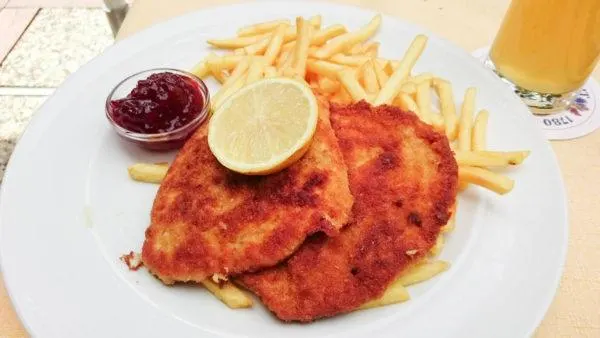
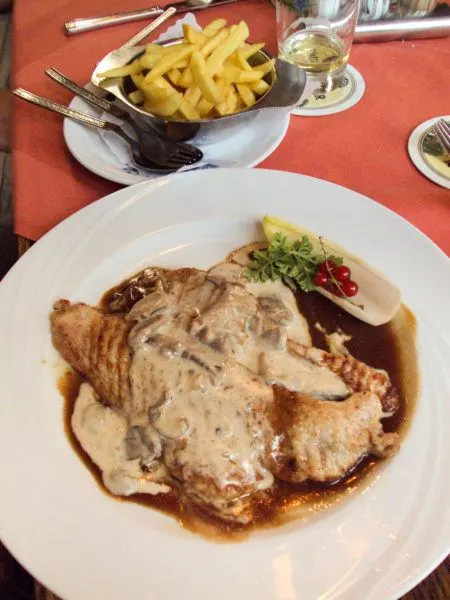
Schnitzel
Shown above, a traditional German schnitzel is breaded pork and served with a wedge of lemon. However, as food has evolved, you can now find all kinds of meat for your schnitzels such as a healthier chicken or turkey. Also, it’s now just as popular to offer the un-breaded meat as well, like you can see in the second photo.
Schnitzel variations and toppings make it so if this is your type of dish, you can have a different one every night of the week. We love the “Jaeger” and the “Zigeuner” schnitzels. The first is a brown mushroom sauce and the second a sauce made out of red peppers. Exploring your taste through schnitzel can keep you busy for your entire vacation.
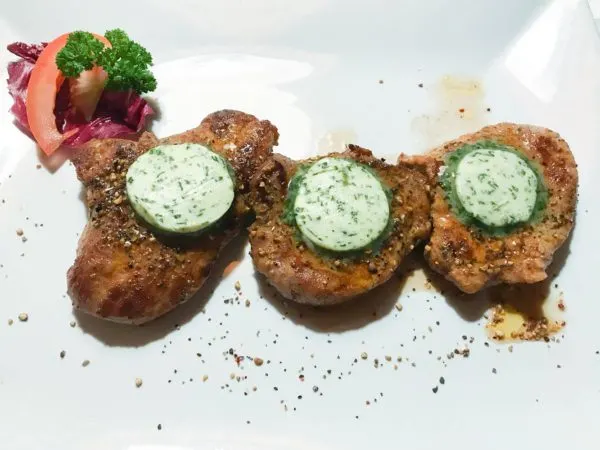
Steaks
Beef is not as popular in Germany as in other parts of the world. However, you will always find at least a few cuts of beef on every menu. The most popular cuts are Rumpsteak and Filetsteak. Sometimes they will offer strips of beef and gravy over rice as well. As pictured, the most typical steak is served with Krauterbutter (herbed butter).
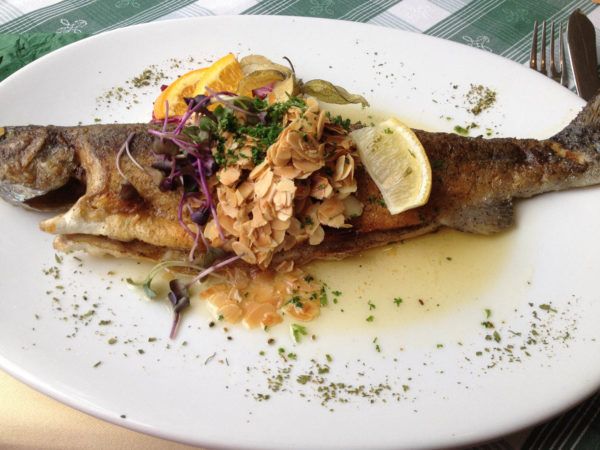
Fish
There are a number of fish dishes always on the menu as well. The best trout can be found where there are trout farms with a restaurant on the grounds. They have these all over the country, but one of our all-time favorites is the Forellenhof.
No worries if you aren’t at a fish farm, fish is really good no matter where you go. Other fish items include: herring (Matjes), Pike (Zander), and, in spring, carp (Karpfen).
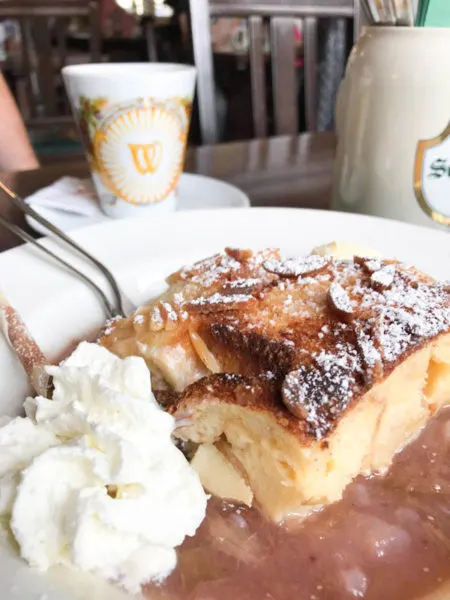

Traditional German Food Guide -Treats and Desserts or Nachttische
As you might expect, German desserts are delectable, and you won’t want to pass up an opportunity to try some as you decide what to eat in Germany. Luckily, you don’t always have to wait until the end of the meal. German cafés are some of the best places to find great pastries, cakes, tortes, and of course ice cream. So, you can stop anywhere along your touring trail for a memorable treat.
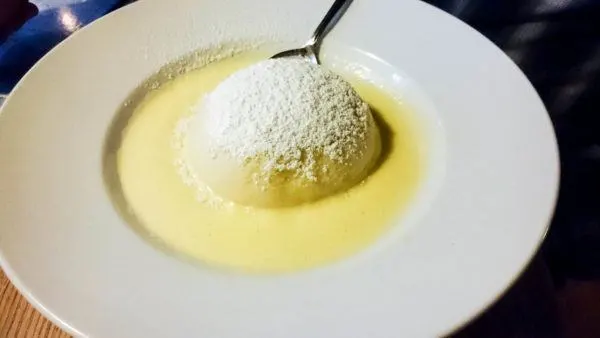
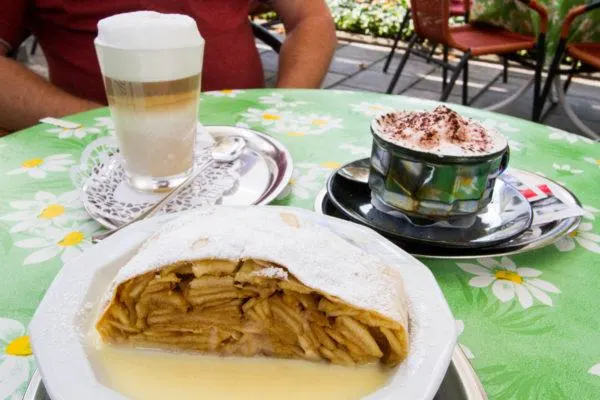
Some notable sweets you should try are:
- Kaiserschmarrn – a pancake usually served with applesauce
- Apfelstrudel – a thin pastry wrapped around apples
- Dampfnudel – a huge, dumpling served with vanilla sauce
- Any cake or torte – from chocolate to fruits, all kinds are yummy!
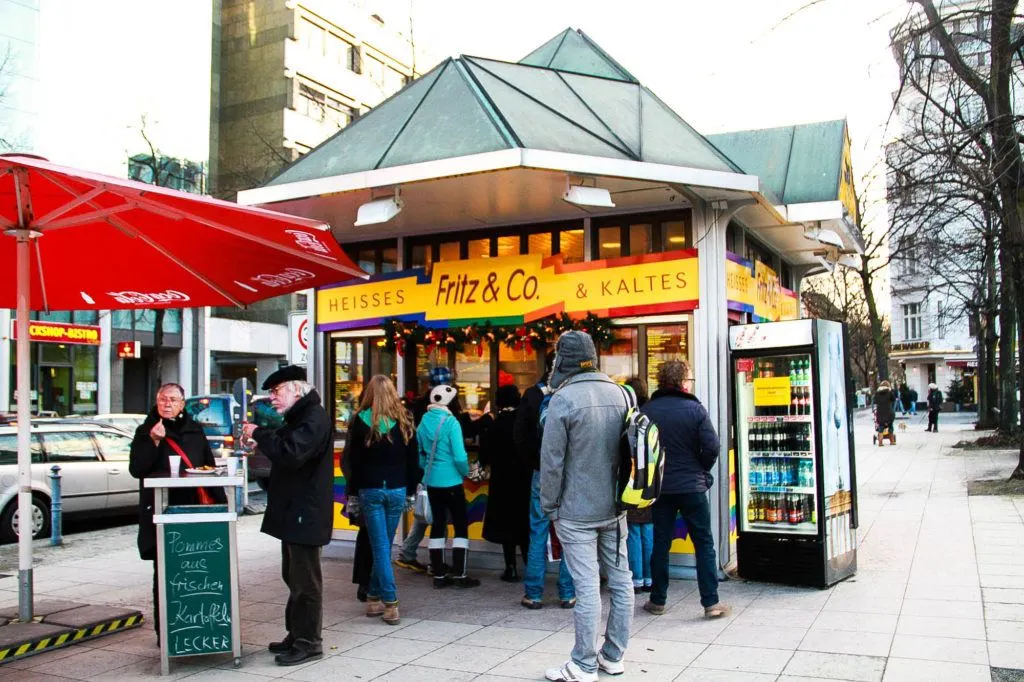
Cheap Eats, Street, and Festival Food
The food in Germany is pretty darn good, but let’s face it. It’s not cheap. No worries, though, if you are looking to save some money on your food budget, you have plenty of options.
We’ve already told you about the amazing grocery stores, bakeries, and markets, but we’ve left one store off that you just must go to – the butcher. Not only is the butcher great for buying fresh meats if you want to cook, but everyday you can eat breakfast or lunch, or even dinner really, as a takeout.
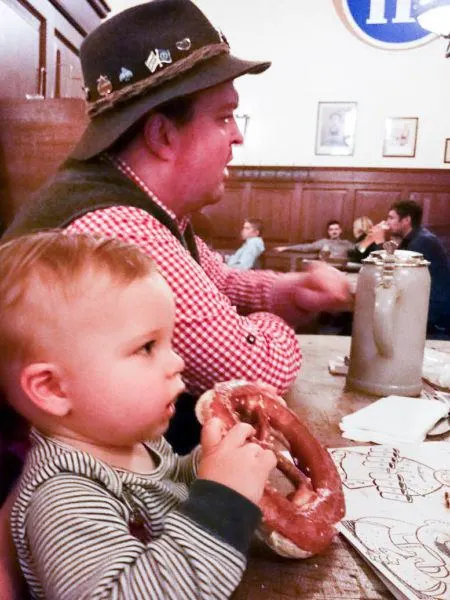
You just go in and order a sandwich made just the way you like it. I used to go in and have my lunch made to take to work. A leberwurst or schnitzel sandwich and a small salad for about 3.50 Euros, cheap and tasty. Some butcher’s will even have a couple of warm choices, like a sauerbraten or warm cutlets. Take my word for it and check them out.
Another way to eat cheap is through German fast food. There are Schnellimbiß stands that sell wursts, french fries, sandwiches, and even doner kebabs. You can usually eat there or take out for about 6 Euros.
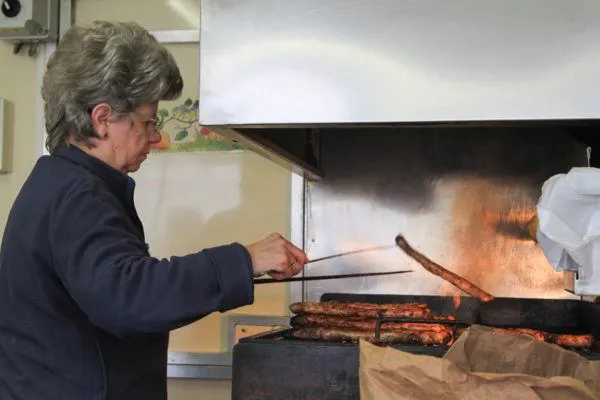
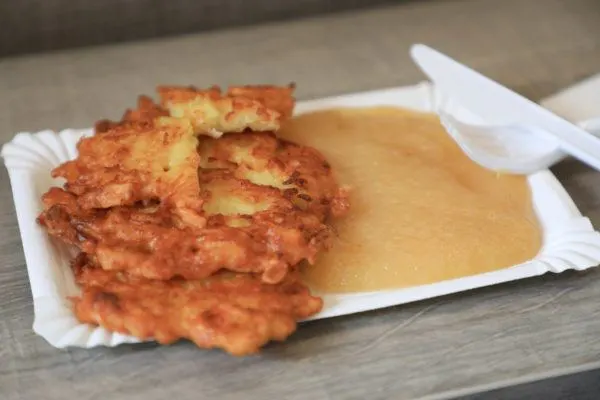
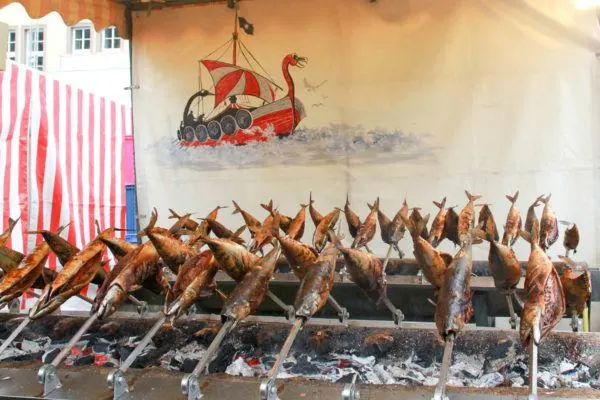
You can’t go wrong trying all the street food stands and festival stands. The variety of foods is pretty amazing and the possibilities are endless when deciding what to eat in Germany.
Some German festival foods you might want to try include when deciding what to eat in Germany:
- potato pancakes, served with applesauce
- mushrooms in cream sauce
- Steckerlfisch – mackerel on a stick
- all kinds of German sausages
- pizza and pizza breads
- Flammkucken– a flat bread with toppings
- chocolate covered fruits – like strawberries and bananas
- crepes
- Langosch – a Hungarian fry bread with toppings
- Mandeln – sugared almonds (and other nuts)
- Dampnudel – dumpling in vanilla sauce
- roasted chicken or hax’n (pork knuckle)
- Gluhwein
- pretzels – both sweet or salty

Typical German Food Kids Will Love
All kids love hot dogs, right? If you have little ones, and are what not sure what to eat in Germany with them, don’t worry. There is plenty of the menu for them to like. Every restaurant will have a kid’s menu. On it will be four or five choices that include all their favorites like chicken nuggets, a wurst, a hamburger, or spaghetti. Then when they are all finished, they will be rewarded with a small sweet like an ice cream or lollipop.
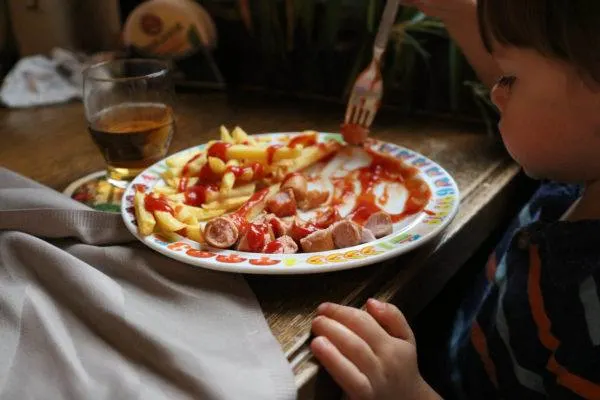
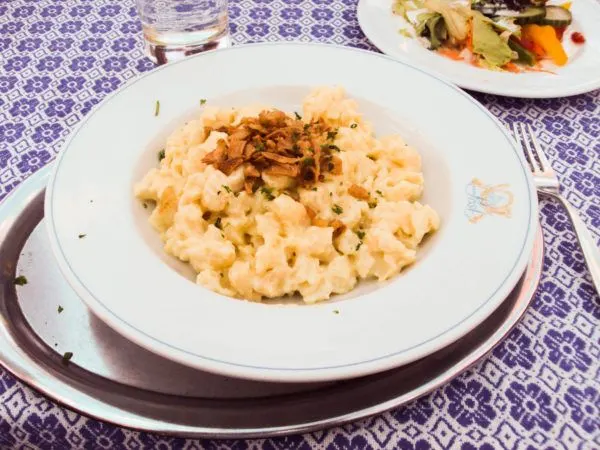
Even if your child doesn’t want to eat off of the kid’s menu, though, there are foods that he or she would love. All kids love a Hackfleisch (meatloaf) and a dish of Käsespätzle (basically macaroni and cheese).
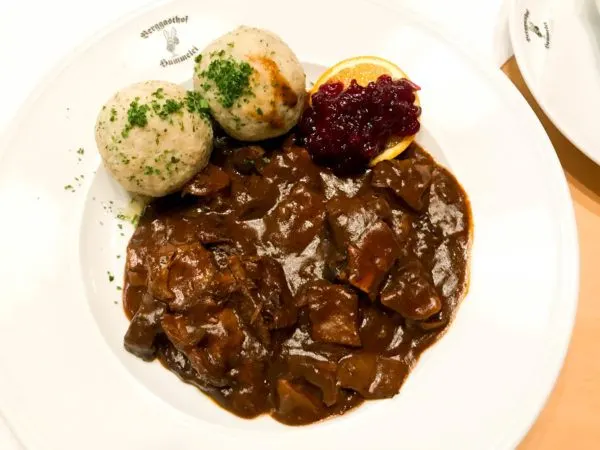
Eating in Germany – Seasonal Dishes To Try
One thing I love about eating in Germany is that each season brings a whole new menu, like when you enjoy Easter in Germany. Most restaurants serve whatever’s fresh and the menu will change accordingly. So, if you’re not sure what to eat in Germany, here if is a small traditional German food guide for every season.
Spring Dishes
- Spargel
- Bärlauch or wild garlic
- rhubarb
- strawberries
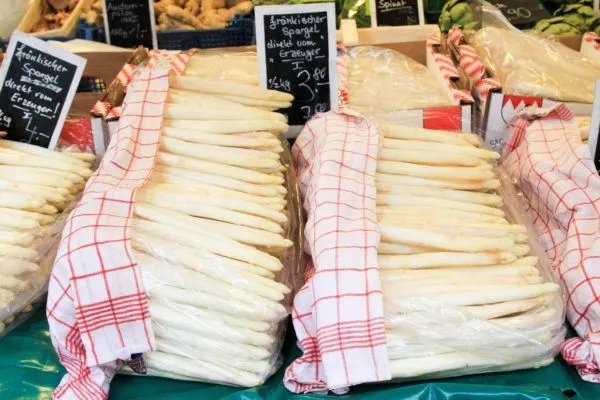
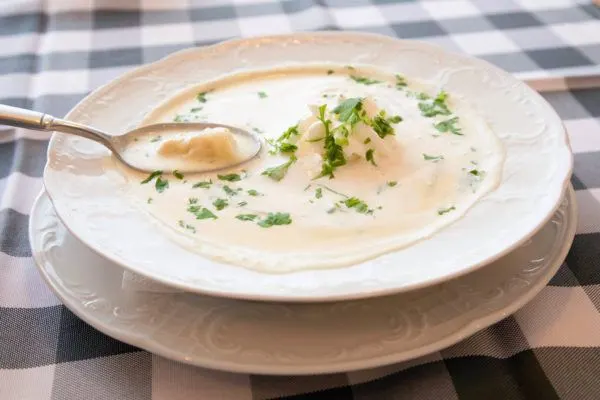
During spring there are two dishes that are a specialty, one of which is my all-time favorite, and that is spargel or white asparagus. Grown under the soil, instead of on top of it, this asparagus has a milder taste. You can find spargel menus all over Germany in spring, where you can try it boiled with hollandaise sauce and potatoes, as a cream soup, and many other ways.
Bärlauch is most commonly seen in a light broth soup. It will sometimes be used to garnish other dishes as well.
Rhubarb and strawberries are the first fruits to be harvested. You can usually buy strawberries in the same stands that you find the spargel. Rhubarb is generally used as a compote and eaten as a tart or in yogurt.
Summer Dishes
- berries – raspberries and currants
- fruits – plums, apricots, peaches, and cherries
- sandwiches and salads

Germany gets surprisingly warm in the summer, and no one really wants a heavy meal. Fish, grilling, sandwiches and salads are abundant choices in Germany in summer.
The fruits and berries are ripening all over the country, and cute little wooden stands will sell them to you from the side of the road. You will also see them in tarts or even just washed and fresh in a bowl to use in your morning muesli.
Desserts across the country will use the fruit in their tortes and ice cream. One of my favorite ice cream dishes is called “heißeliebe” or “hot love.” It’s vanilla ice cream with a hot raspberry sauce…try it!
Fall Dishes
- pumpkin
- wild game – deer and boar
- mushrooms
- beetroot and red cabbage
- Linseneintopf – a hearty pea soup with wurst

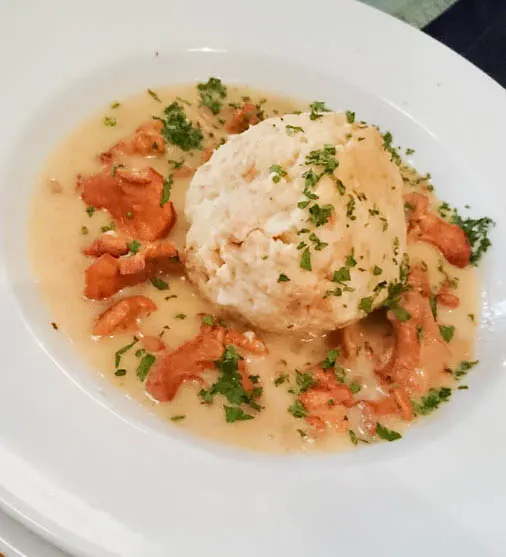
The crisp weather kicks in rather early in Germany, so it’s no secret that the heavier fare is back in vogue. Two of the dishes you see the most in Germany in fall are pumpkin soup and pfifferlinge (Chanterelles) in many forms.
Soups are the best way to shake off an evening chill, and there are plenty of choices when deciding what to eat in Germany in the fall. It seems we cannot pass a chance at having pumpkin soup, but we do like a bunch of others as well. Another favorite of mine is the Linseneintopf, a pretty full meal all by itself, it’s like a pea soup on steroids.
Fall is the season for hunting, and one of the most popular dishes is hirsch or deer. Hirschgulasch has a deep dark brown sauce and is often paired with bread dumplings to soak it up. These hearty dishes require just as hearty vegetables and the beetroots and cabbages come back.
Winter Dishes
- goose
- sauerkraut
- all kinds of cabbages and radishes
- chestnuts
- stollen
- Lebkuchen or Pfeffernusse cookies
Germany in winter is dark and cold. Thankfully there are plenty of Christmas markets to lighten the mood. Perhaps the most traditional dish of the season is a baked goose usually served with rotkohl (red cabbage) or sauerkraut.
In fact all kinds of cabbages and stuffed foods make their debuts. From stuffed cabbage to stuffed beef rolls, you’ll want to try them all.
A few of the holiday foods that you’ll come across are roasted chestnuts, and delicious sweets like Christmas stollen, Lebkucken, and Pfeffernusse cookies.
Traditional German Food Guide: Top 5 Foods You Must Try in Germany

Schnitzel – Yes, we absolutely love schnitzel. Pork, chicken, stuffed with cheese and ham, or covered in a variety of schnitzel toppings. They are iconic and scrumptious, and easy to make at home.
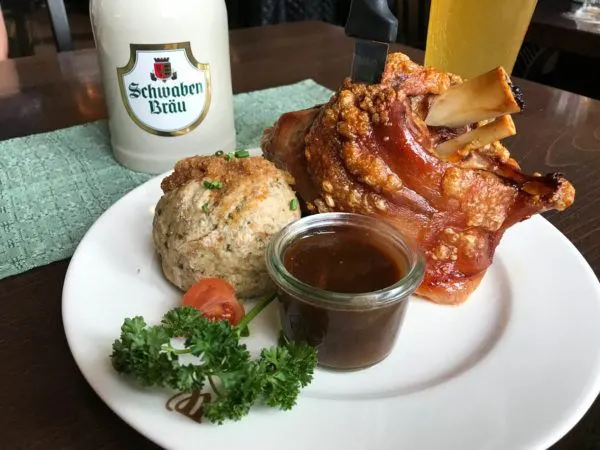
Schweinshaxe or pork knuckle, roasted not boiled, is mostly a Bavarian dish. You can find it at the Oktoberfest or all year in Munich and the surrounding area. It’s big, full of calories, and everyone needs to try it at least once.

Käsespäzle – What’s better than melted cheese and homemade noodles? It will please kids of all ages, it’s vegetarian, and it’s amazing.
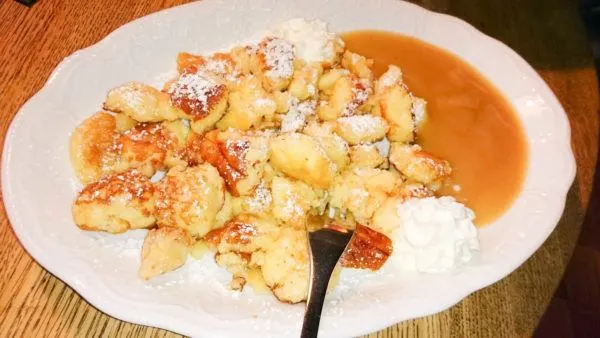
Kaiserschmarrn – Whether you choose to eat these sweet pancakes as a whole meal or as a dessert is up to you, but make sure to try it. Topped with raisins, powdered sugar and applesauce. It’s truly a treat. Now you can try it at home!

Spaghetti Eis – I’ve not met one person who didn’t love spaghetti eis. This ice cream looks just like a plate of our favorite noodles, but instead it’s a strawberry and white chocolate sundae. So yummy!
Conclusion
When traveling to Germany, no matter what time of year, we have you covered with our traditional German food guide, so you’ll know what to eat in Germany at the restaurant, market, or festival.
If You Liked German Food Guide...
Author Bio: Corinne Vail is a travel photographer, food lover, and a perpetual traveler who has been travel writing for over 14 years. For many years she lived overseas in Germany, Japan, Turkey, South Korea, and the Netherlands teaching the children of the US. military. She’s visited over 90 countries, and she’s not stopping anytime soon.
Pin What To Eat in Germany
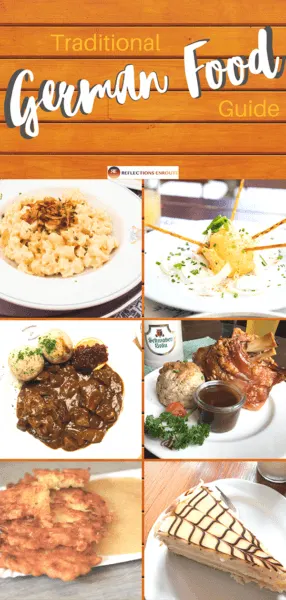




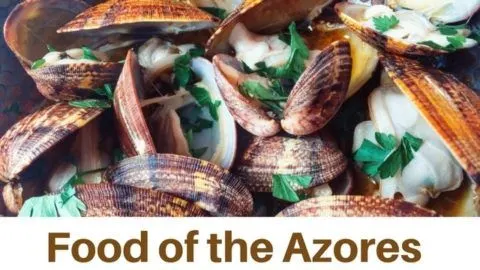

Johannes James Agate
Saturday 21st of August 2021
This was a great guide and shows a variety of really good food. My Mother was German and I have sent many Happy times. I love Germany its food and I always found the germans very friendly.. Looking forward to going over again.